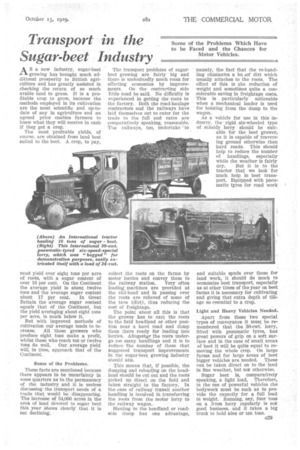A S a new industry, sugar-beet growing has brought much additional
Page 67

If you've noticed an error in this article please click here to report it so we can fix it.
prosperity to British agriculture and has greatly assisted in checking the return of so much arable land to grass. It is a profitable crop to grow, because the methods employed in its cultivation are the most scientific and up-todate of any in agriculture and an agreed price enables farmers to know what they will receive in cash if they get a crop.'
The most profitable yields, of course, are obtained from land best suited to the beet. A crop, to pay, must yield over eight tons per acre of roots, with a sugar content of over 16 per cent. On the Continent the average yield is about twelve tons and the average sugar content about 17 per cent. In Great Britain the average sugar content equals that of the Continent, but the yield averaging about eight tons per acre, is much below it.
But with improved methods of cultivation our average tends to increase. All those growers who produce eight tons make a profit, whilst those who reach ten or twelve tons do well. Our average yield will, in time, approach that of the Continent.
Some of the Problems.
These facts are mentioned because there appears to be uncertainty in some quarters as to the permanency of the industry and it is useless discussing• the transport needs of a trade that would be disappearing. The increase of 54,000 acres in the area of had devoted to sugar beet this year shows clearly that it is not declining. The transport probteins of sugarbeet growing are fairly big and there is undoubtedly much room for effecting economies by improvements. On the contracting side little need be said. No difficulty is experienced in getting the roots to the factory. Both the road-haulage contractors and the railways have laid themselves out to cater for the trade to the full and rates are comparatively speaking, reasonable.' The railways, too, undertake 'to collect the roots on the farms by motor lorries and Convey them to
the railway station: Very often loading machines are provided at the rail-headand in passing over the roots are relieved of some of the tare (dirt), thus reducing the cost of freightage.
The point about all this is that the grower has to cart the roots to the field headland or other position near a hard road and dump them there ready for loading into lorries. Altogether the rciots undergo too many handlings and it is to reduce the number of these that suggested transport improvements in the sugar-beet growing industry
should aim. .
• This means that, if possible, the dumping and reloading on the headland should be cut out and the rootspicked up direct on the field and taken straight to the factory: In the case of railway. transit another handling is involved in, transferring the roots from the, motor lorry to
the railway wagon., • Hauling to the headland or roadside dump has one advantage,
namely; the fact that the re-handling eliminates a lot of dirt which usually attaches to the roots. The effect of this is the reduction of weight and sometimes quite a considerable saving in freightage costs. This is particularly noticeable when a mechanical loader is used for hoisting from the dump to the wagon.
As a vehicle for use in this industry, the rigid six-wheeled type of subsidy lorry should be suitable for the beet grower, as it is capable of traversing ground otherwise than
hard roads. This should•help to reduce the number
of handlings, especially while the, weather is fairly dry. • But it is to the tractor that we look for much help in beet transport. Equipped with pneumatic tyres for road work and suitable spuds over these for land work, it should do much to economize beet transport, especially as at other times of the year on beet farms it is necessary for cultivating and giving that extra depth of tillage so essential to a crop.
Light and Heavy Vehicles Needed.
Apart from these two special types of conveyance it must be remembered that the 30-cwt: lorry, fitted with pneumatic tyres, has great powers of grip on a soft surface and in the case of small areas of beet it will be quite equal to removing the whole crop. On large farms and for large areas of beet bigger vehicles are needed. These can be taken direct on to the land In fine weather, but not otherwise.
Sugar beet is, comparatively speaking, a light load. Therefore, in the use of powerful vehicles the bodywork must be such as to provide the capacity for a full load in weight. Running, say, four tons on a 5-ton lorry, regularly is not good bu:siuess, -and it takes a big truck to hold nine or ten tons.




























































































































